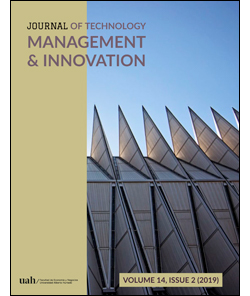A Co-evolution Framework towards Stable Designs from Radical Innovations for Organizations Using IT
DOI:
https://doi.org/10.4067/S0718-27242019000200044Keywords:
socio-technical systems, radical innovations, open systems, co-evolution, case studies.Abstract
The purpose of this paper is to theoretically and empirically explore how organizations can enable radical product innovations to cumulate as stable designs. Radical product innovations are organizational responses to external triggers that cause transitions. To manage in transitions, it is necessary for radical product innovations to cumulate as stable designs. Organizations ability to co-evolve with the environment does influence innovations to cumulate as stable designs; to examine this, the author selected public procurement that uses IT as radical product innovation with pronounced environmental influence, government’s interventionist approach. The author used multiple case-study and obtained diverse analytic and heuristic views. From the cases, the author noted that actors did consider local and contingent factors only that resulted in certain radical innovations cumulating as stable designs. As an initial starting point, such actions are appropriate but organizational actions to expand their initial actions with a co-evolutionary framework that considers social contexts.Downloads
References
Avgerou, C., & Madon, S. (2004). Framing IS studies: understanding the social context of IS innovation (pp. 162-182). Oxford University Press, Oxford.
Blair, E. (2015). A reflexive exploration of two qualitative data coding techniques. Journal of Methods and Measurement in the Social Sciences, 6(1), 14-29.
Colebatch, H. K. (2005). Policy analysis, policy practice and political science. Australian Journal of Public Administration, 64(3), 14-23.
Conboy, K. (2009). Agility from first principles: Reconstructing the concept of agility in information systems development. Information systems research, 20(3), 329-354.
Corbin, J. M., & Strauss, A. (1990). Grounded theory research: Procedures, canons, and evaluative criteria. Qualitative sociology, 13(1), 3-21.
Fedorowicz, J., Gogan, J. L., & Culnan, M. J. (2010). Barriers to interorganizational information sharing in e-government: A stakeholder analysis. The Information Society, 26(5), 315-329.
Geels, F. W. (2002). Technological transitions as evolutionary reconfiguration processes: a multi-level perspective and a case-study. Research Policy, 31(8-9), 1257-1274.
Geels, F. W. (2006). Co-evolutionary and multi-level dynamics in transitions: the transformation of aviation systems and the shift from propeller to turbojet (1930–1970). Technovation, 26(9), 999-1016.
Geels, F. W., & Schot, J. (2007). Typology of sociotechnical transition pathways. Research Policy, 36(3), 399-
Geels, F. W., & Verhees, B. (2011). Cultural legitimacy and framing struggles in innovation journeys: a cultural-performative perspective and a case study of Dutch nuclear energy (1945–1986). Technological Forecasting and Social Change, 78(6), 910-930.
Hossieni, S., Dehkordi, G. J., & Aghapour, H. A. (2012). Insights into case study: A discussion on forgotten aspects of case research. International Journal of Scientific and Research Publications, 2(3), 1-6.
Hutchby, I. (2001). Technologies, texts and affordances. Sociology, 35(2), 441-456.
Hyde, K. F. (2000). Recognizing deductive processes in qualitative research. Qualitative market research: An international journal, 3(2), 82-90.
Kompella, L. (2017). E-Governance systems as socio-technical transitions using multi-level perspective with case studies. Technological Forecasting and Social Change, 123, 80-94.
MacKenzie, D., & Wajcman, J. (1999). Introductory essay: the social shaping of technology. The social shaping of technology, 2, 3-27.
Malerba, F. (2006). Innovation and the evolution of industries. Journal of Evolutionary Economics, 16, 3-23.
McKelvey, B. (1997). Quasi-natural organization science. Organization Science, 8(4), 352-380.
Mital, M., Pani, A. K., Damodaran, S., & Ramesh, R. (2015). Cloud based management and control system for smart communities: A practical case study. Computers in Industry, 74, 162-172.
Nag, B. (2013). Combating Corruption in Public Procurement-A Case Study of the Indian Railways.
Porter, T. B. (2006). Coevolution as a research framework for organizations and the natural environment. Organization & Environment, 19(4), 479-504.
Raven, R. P. J. M., & Geels, F. W. (2010). Socio-cognitive evolution in niche development: Comparative analysis of biogas development in Denmark and the Netherlands (1973–2004). Technovation, 30(2), 87-99.
Raven, R., Schot, J., & Berkhout, F. (2012). Space and scale in socio-technical transitions. Environmental Innovation and Societal Transitions, 4, 63-78.
Russo, M. V., & Fouts, P. A. (1997). A resource-based perspective on corporate environmental performance and profitability. Academy of management Journal, 40(3), 534-559.
Schein, E. H. (2010). Organizational culture and leadership (Vol. 2). John Wiley & Sons.
Schot, J., & Geels, F. W. (2008). Strategic niche management and sustainable innovation journeys: theory, findings, research agenda, and policy. Technology analysis & strategic management, 20(5), 537-554.
Slayton, R., & Spinardi, G. (2016). Radical innovation in scaling up: Boeing’s Dreamliner and the challenge of socio-technical transitions. Technovation, 47, 47-58.
Von Bertalanffy, L. (1950). The theory of open systems in physics and biology. Science, 111(2872), 23-29.
Waring, T. M. (2010). New evolutionary foundations: Theoretical requirements for a science of sustainability. Ecological Economics, 69(4), 718-730.
Witt, U. (2008). What is specific about evolutionary economics? Journal of Evolutionary Economics, 18(5), 547-575.
Yin, R. K. (2009). Case study research: Design and methods. Sage publications.
Zammuto, R. F., Griffith, T. L., Majchrzak, A., Dougherty, D. J., & Faraj, S. (2007). Information technology and the changing fabric of organization. Organization science, 18(5), 749-762.
Downloads
Published
How to Cite
Issue
Section
License







